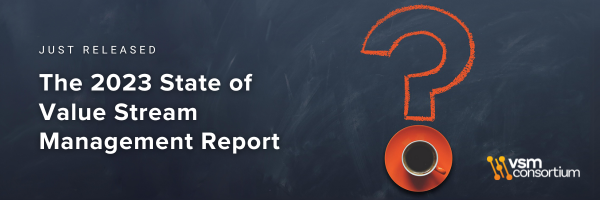One of the big problems in business, and digital product delivery today, is that we all have a mountain of issues to deal with and it’s really hard to figure out where to get started, or how to find the time. Value stream management (VSM) offers a solution to this. By orientating your organization to your customer, everything starts to make sense: shorter and better feedback on your decisions; less work for work’s sake; better connectivity from idea to value realization. But this raises another problem… how to get started with VSM.
So here are five tips to get started on your value stream management journey:
- Start with the problem—a real problem you have today
- Listen to the person on the ground
- Improve your situational awareness
- When in doubt, develop the situation
- Share your vision and ask for help
1. Start with the problem: your problem
I'm going to assume you're here because you've heard about VSM and want to get started. The absolute best way is to start with a problem that you have today, and use principles from VSM to start to tackle it. This way you’ll get maximum bang for your buck in terms of time, effort and goodwill. So the first step is identifying a problem that you can use to articulate the benefit of starting the journey, and to draw people to your vision.
There are hundreds of common problems…
- “Our team doesn’t know how our work is being used”
- “We haven’t connected our software delivery pipeline”
- “We can’t deliver change fast enough”
- “We are spending too much money”
- “We are too busy, we have too much to do”
A core principle from VSM is to think holistically, and from the customer’s point of view, so we can translate these problems to make them customer centric:
|
From |
To |
|
“Our team doesn’t know how our work is being used” |
Our team doesn’t know what’s valuable to our customers |
|
“We haven’t connected our software delivery pipeline” |
It takes ages to launch new features and we can’t react quickly to new customer needs |
|
“We can’t deliver change fast enough” |
Our developers spend so much time dealing with tooling that they’re completely isolated from our customers, and our platforms are creaking |
|
“We’re being told we’re spending too much money” |
We can’t join the dots between our infrastructure problems and our customer experience because investment decisions are made at really high level / annually / based on lagging indicators like profitability |
|
“We are too busy, we have too much to do” |
We don’t understand what’s most valuable to our customers |
Find the one problem for your team or area. You’ll know it when you find it—it’s that zombie issue that you can’t kill, or maybe a root cause that keeps coming back from the dead in different forms. Once you have a problem that you and your team can rally around, you can start to get buy-in to do something about it, and build momentum from there!
2. Listen to the person on the ground
It’s a general rule that whoever you are, someone somewhere has key information or a better idea than you do for the problem you’re facing (even if you might have the best overview). If you’re leading any change, your instinct should be to find that information and build it into your plan. More generally, organizations fall over when they stop listening to the people closest to the ‘problem’ underlying their product or service’s ’solution’.
A key principle of value stream management is that the customer is the person receiving the ‘value’ your organization produces—and that focusing on that value will lead to organizational success. Beneath this, the two big pillars are firstly to optimize the flow of work that delivers value, and secondly to measure value realization, and then use that feedback to determine what to do next.
So this tip is to get started by finding the people on the ground and talking to them—asking about their perspectives on the flow of work, and on value realization. They might not think about it in these terms, so consider the language and adapt it as you judge appropriate. The first thing you’ll gain is improved situational awareness, and beyond that you’ll also quickly discover who’s help you need, and who needs your help so that you can improve your value stream management together.
3. Improve your situational awareness
This is a basic principle from all forms of leadership, and getting started with VSM is no different. In essence, situational awareness is simply knowing what’s going on around you—but the quality of your perception will depend on the richness of your understanding of the different angles. It therefore has a different meaning depending on your role, your team, and your organization—but it’s the foundation of good decision-making. Value stream management has re-surged in relevancy in the last few years because we now have tooling that can span entire digital value streams: great situational awareness! We like to think that the power of digital VSM is that it ties together the movements of agile, DevOps, and SRE in a way that makes sense to the business—because it orientates everything in terms of customer value. A key principle is that there is no gap between technology and business—there is one organization.
In general our situational awareness improves simply as time passes, or as we apply common-sense to understanding our environment, or by listening to the person on the ground—which means the person closest to the problem. In a modern digital business that might be the customer, or the platform engineer, or the front end developer: all see the situation from different angles and all angles are required for holistic understanding. It’s essential to have context before making critical decisions (and to find ways to fail fast and safely); moreover, risk-aversion is a symptom of not understanding what's going on around you—and taking risk is vital to success.
So this tip is to take a first step to improve your situational awareness. This might be as simple as asking one of your team about the problems they’re currently tackling—or the ones they aren’t tackling that they’re most worried about. Even better, it might be to set some time up with a group from across different organizational functions to share knowledge and insight—you never know what great ideas this will produce. Value stream mapping is a great way to make this happen, and ensure you have shared situational awareness.
4. When in doubt, develop the situation
Creative problem solving is part of the job description for any leader, but often the weight of bureaucracy and the tendency toward complacency get in the way. All change or improvement initiatives require great effort to turn resistance and wrangle through existing systems. Changing ways of working requires changing ways of thinking—and it’s hard. I’m sure you’ve already heard that ‘culture’ is the last thing to change, and fiendishly difficult… so how do you decide what to do and how to start?
There are huge advantages to using experiments to fail safely. At a basic level, agile emphasizes this in scrum (short, iterative feedback loops), and XP (e.g. TDD, pair programming). In the context of value stream management, we also recommend starting small and building momentum. This avoids the two big problems: decision paralysis, and taking on too much—and therefore using up your goodwill, energy, and enthusiasm before you’ve reached your goal.
The tip here is to form your decisions around the goal of developing the situation—and start small. If we look back to our implementation roadmap, every step on this path develops the situation—but within each step there are countless ways to make progress. In our research we have found many people from especially massive organizations that are only partially through the implementation path… and this is great! They have laid the groundwork for further evolution. Moreover, one of the advantages of VSM platforms is that they allow you to connect, visualize and control your value stream(s) without re-architecting the enterprise—which requires a significant undertaking at all levels of the organization.
5. Share your vision and ask for help
Leading on from our previous tip, we strongly believe that any vision for change will greatly benefit from experimentation, and will (should!) evolve over time as you gain experience. One of the best ways to get consensus, and buy-in is to incorporate feedback from representative people across the organization. This is especially important for VSM adoption. Value streams generally cut across traditional organizational boundaries (e.g. technology vs business; accounting vs sales vs operations)—so this might be as simple as talking to people outside the boundaries of your team, and connecting with others who contribute to the same product or service as you.
Your vision will get stronger as you test it against others’ perspectives, and more resilient as you build consensus and interest—you want a zombie solution to tackle your zombie problem—a solution that can be criticized, but not killed. Moreover, however many patterns you recognize, they won't do any good unless they're shared. Returning to tip one, if you have a vision that helps solve a shared problem then you’re much more likely to pick up enthusiastic people around you to help—and start exploring ideas with you. If you’ve improved your situational awareness, listened to the people on the ground, and taken active steps to develop the situation, then your understanding of the problem has likely evolved—and you may have even uncovered some creative solutions.
Building on this, we also emphasize the importance of finding a good narrative for your vision—our brains love stories, which is why they’re so much more compelling than data. So to sell your vision, find a story that works for everyone involved: if you can find benefits for your colleagues across the organization, and pitch them in narrative form, then you’re well on your way to gaining the support you need to press on further ahead with your VSM journey after your initial successes. It does help to have the data in your back pocket too: data defeats criticism, but narrative wins hearts and minds.
In summary, these tips are all about just starting wherever you are. Start looking, start talking to people, and start applying your hard-won common sense to the opportunities to move forwards with your value stream(s). Looking for gaps in our understanding can lead to innovative solutions, opportunities for adaptation, and potential to seize bold opportunities. Following the VSM implementation roadmap will help you plot a way forward. In the process, hopefully you’ll also find that you’re discovering who you can ask for help, who needs your help, and the ingredients to develop your vision.
However small you start with your VSM implementation, you’ll be able to circle back on the roadmap and apply the same tips to your journey with other value streams. Eventually you’ll have a fully connected value stream network—that you’re actively adapting with data. Best of luck, and let us know how you get on!

Rupert Field
DevOps coach and servant-leader with background leading technology product delivery and agile transformation. Excellent experience in product and value-stream management. Gets things done.









Comments 0